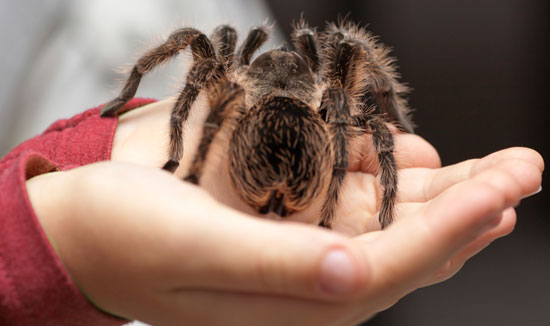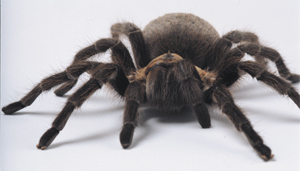How to Keep Spiders as Pets
Spiders can make fascinating pets. Here are a few steps to get you started keeping spiders.

Step 1: Catch a spider
Spiders are all around us, indoors and out, so they’re not hard to find. Some species can bite and a few are venomous. Learn about dangerous spiders in your area before heading out. It’s easy to safely catch a spider by using a small jar. Gently coax it into the jar using the lid. Spiders will eat each other, so keep only one per jar.
Step 2: Prepare a cage
Large spiders do well in the inexpensive plastic terrariums available from pet stores. Smaller ones can be kept in jars or plastic containers if air holes are drilled into the lid or sides. Be sure the holes are small enough to prevent escape.
Potting soil makes good cover for the cage bottom. Sticks, dead leaves or artificial plants provide structure for hiding, climbing and webbing.
Step 3: Water
Depending on the size of the spider, anything from a plastic bottle cap to a small bowl can serve as a water dish. Spiders also drink water sprayed on webbing, but you should never allow the cage to become damp.
Step 4: Feeding
Offer insect prey once or twice a week. Crickets are available from pet shops, or you can collect insects outdoors if no insecticides have been sprayed in the area.
Step 5: Observing
Watch your spider and take notes on its behavior. You won’t believe what happens in the spider’s web until you’ve visited it yourself!
PREFERRED PETS
 Not all spiders do well in captivity. Active hunters are usually easier to keep than web builders. Here are a few that make good pets.
Not all spiders do well in captivity. Active hunters are usually easier to keep than web builders. Here are a few that make good pets.
Tarantulas: Some species exceed 10 inches in legspan. They’re by far the most popular pet spiders and can be bought in pet stores.
Wolf Spiders: Some can be more than three inches in legspan. Large specimens do best in terrariums with lots of floor space.
Jumping Spiders: Although small and rarely exceeding half an inch, their jumping ability is amazing. Many species are brightly colored and can easily be kept in jars.
Fishing Spiders: In captivity, these large spiders appreciate vertically arranged pieces of bark for climbing. They’re very fast, so use caution when capturing them.
Grass Spiders: These spiders build funnel-shaped webs in grass, bushes and on buildings. In captivity, they will build extensive webs inside their cage.
LEARN MORE: Click here to see photos of a spider expert’s seven favorite spiders
I found a baby house spider inside, and I really wanted to keep it tilit was bigger. She/he is no bigger than the dot in this ‘i’ what should I feed her? Maybe bits of meat till she is bigger than a knat?
how often do i clean a jumping spiders cage/how do i get rid of it
i have a crab spider and i have in a pet carrier is that ok?
Well I once put three spiders in a jar,two of them had squishy red butts and black bodys.And then two wolf spiders…why dident they fight?
I have a tarantula, she will not eat? What could be wrong?
she probably got bored of her diet.
She is moulting her exoskelton
I have a pet black house spider
wow
uhhhh i read some research and well,,, it said that house spiders arent black…. yeah so what ever you have isnt a house spider. might wanna find out what it is. could be deadly could be not deadly.
ive been feeding wild jumping spiders in my hydroponic lettuce raft for a few days. i find midges or small flies, and they jump fast like rattlesnakes. pretty neat. time will tell if they tame for treats. what if you could domesticate spiders? “here deliver this secret microchip to griswald in accounting, he’ll know what to do!” lol! great creatures
love the nature
I have a grass spider and it lives in an old clear jar it loves eating earwegs and grasshoppers.
I have a bunch of water spiders is it ok to bring them inside for winter? If not what should i do to keep them warm all winter? They need to live or i will be crushed.
I was planning to buy a tarantula, i think i will feed it with cockroaches like my scorpion.
Don’t do that! do your research and feed the fragile spider right. Tarantulas want crickets and flies and meal worms. not cockroaches.